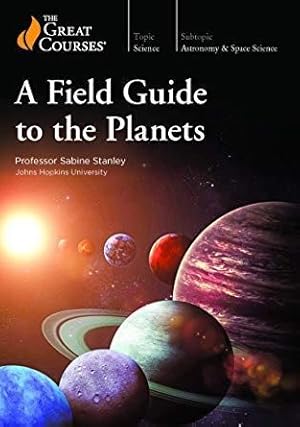A Field Guide to the Planets
(By Sabine Stanley)

| Size | 21 MB (21,080 KB) |
|---|---|
| Format | |
| Downloaded | 584 times |
| Last checked | 8 Hour ago! |
| Author | Sabine Stanley |
Since those famous steps were taken, we’ve discovered what is approaching 200 additional moons of all shapes, sizes, and compositions. We’ve sent spaceships and robotic laboratories to photograph and study each of the planets, dozens of moons, and even the Sun. We’ve discovered ring systems around three additional planets; landed robotic explorers on Mars, on asteroids, and even on comets. We’ve also found thousands of exoplanets around other stars, with implications for our own origins. There has never been a more exciting time than today to explore and understand our solar system and beyond with A Field Guide to the Planets.
Your instructor, Professor Sabine Stanley, a Bloomberg Distinguished Professor at Johns Hopkins University, guides you on a thrilling ride of discovery, illustrated by the phenomenal images NASA has gathered from throughout the solar system. In 24 lectures, you will experience a journey that was never before possible as your professor makes these astronomical wonders accessible to anyone, allowing you to experience, via our robot explorers, what it is like to visit worlds that were previously unknown.
What Is Our Solar System?
When we think of the solar system, we tend to visualize it in two dimensions, generally as a map with planets orbiting in almost circular ellipses around the Sun. We also imagine some moons in that same plane, an asteroid belt, a few more planets and satellites, and maybe a comet coming in at a different angle. Our visual map tends to end with Neptune, the eighth and farthest planet from the Sun, and the Kuiper Belt objects, including Pluto.
And yet the solar system is also so much more. We now know that even Neptune’s orbital distance is less than one tenth of one percent of the distance from the Sun to the farthest objects bound by its gravity—the Oort Cloud, a spherical shell of small icy bodies orbiting the Sun 50,000 times farther out than the Earth. The solar system that began its formation 4.5 billion years ago is still a work in progress today—a three-dimensional, dynamic, ever-changing system of energy and matter all gravitationally bound to our star.
And if we had any doubts about the continuing forming and re-forming of the solar system, recent exploration has allowed us to:
Witness for the first time a collision between two bodies in the solar system—Jupiter’s gravity capturing comet Shoemaker–Levy 9, ripping the comet apart, and causing it to crash into the planet;
Monitor active volcanic eruptions on moons of Jupiter, Saturn, and Neptune; and
Discover propeller moonlets constantly shaping and reshaping the rings of Saturn.
These and other observations have helped fill out our knowledge of the solar system—and by doing so, has helped us better understand our own place in the universe, too.
A Grand Scale and Unique Features
Earth is home to spectacular features created by erosion, plate tectonics, and collision impacts over billions of years. But many of Earth’s features pale in scope compared to those on other planets and moons. As we’ve explored farther out into the solar system, we’ve encountered features whose magnitude we hadn’t anticipated or even imagined, such as:
Jupiter’s Auroras. Some of the most energetic auroras in the solar system, they are 1,000 times more powerful than those on Earth and are emitted not just as visible light, but as high-energy X-rays.
Verona Rupes. A cliff face on Uranus’ moon Miranda, measuring 20 kilometers high. With a gravitational acceleration 100 times smaller than Earth’s, a rock falling from the top would take almost 12 minutes to reach the bottom.
Olympus Mons. Located on Mars, it’s the solar system’s tallest mountain and largest known volcano, measuring an amazing 27 kilometers tall. But when it comes to volcanic activity, Jupiter’s moon Io is the winner with 400 active volcanoes mapped to date.
Diamond Rain. On Uranus and Neptune, it’s possible that carbon atoms could condense into crystals of diamonds that would rain out through the icy layer above. Uranus might even have an ocean of carbon under high pressure with floating chunks of solid “diamond-bergs.”
With Professor Stanley’s guidance, you’ll learn more about these and dozens of other unexpected features and objects—from the surprising prevalence of water throughout the solar system (even on blazing hot and dry Mercury); to puzzling shapes on the Moon; to the quantity of near-Earth objects we need to track for safety, now numbering upwards of 20,000.
Looking Outward to Understand Ourselves
One thing we’ve learned from our solar system exploration is precisely how the Earth is unique—and not just because our planet is teeming with life: Earth is the only planet or moon whose surface has be...”













